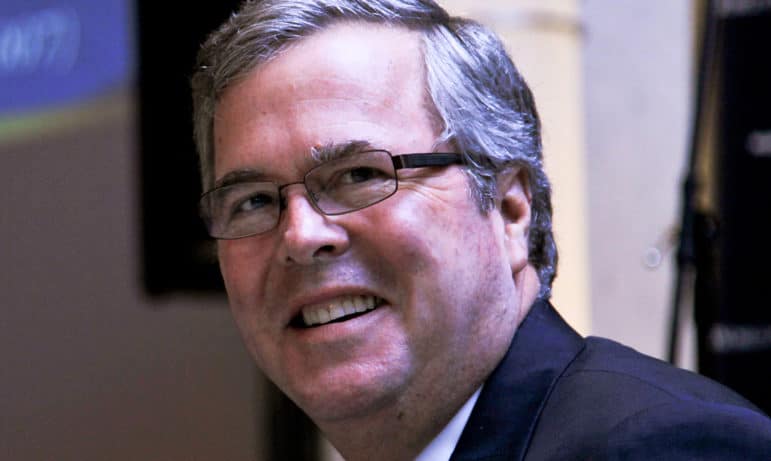
The World Affairs Council of Philadelphia / Creative Commons
So far, October’s biggest presidential advertiser, Right to Rise USA, is a super PAC created to boost former Florida Gov. Jeb Bush. (Photo cc info)
In the heaviest advertising month yet during the 2016 presidential campaign, non-candidate groups such as super PACs and politically active nonprofits have dominated the airwaves.
Such organizations, made possible by the Supreme Court’s 2010 Citizens United v. Federal Election Commission decision, ran more than 8,400 presidential race-focused ads from Oct. 1 through Oct. 26, according to a Center for Public Integrity analysis of data provided by advertising tracking firm Kantar Media/CMAG.
In contrast, only one Republican presidential candidate has sponsored his own ads. Retired neurosurgeon Ben Carson aired more than 400 spots last week, according to preliminary data.
The October ad data represents a dramatic outsourcing of presidential campaign messaging. Not even during the 2012 Republican primaries, when super PACs first began supporting presidential hopefuls, did candidate campaigns so completely cede their paid TV messaging to proxy groups.
Wednesday’s Republican debate in Boulder, Colo., however, allowed voters to tune their televisions to CNBC and hear directly from the presidential candidates themselves.
The advertising landscape in the Republican presidential primary contrasts sharply with the Democratic one, where 96 percent of TV ads aired so far have been sponsored by candidates — although there have been far fewer Democratic TV ads overall.
Former Secretary of State Hillary Clinton, who leads in the polls, has paid to air roughly nine out of every 10 ads on the Democratic side. A pro-Clinton super PAC, Priorities USA Action, announced its first TV ad last week.
The only super PAC that has so far aired a significant number of ads in the Democratic race — Generation Forward, which is supporting former Maryland Gov. Martin O’Malley— has sponsored fewer than 200 ads.
U.S. Sen. Bernie Sanders of Vermont, who has challenged Clinton’s lead in some early state polls, has yet to air an ad. Harvard Professor Larry Lessig, another Democratic candidate, has sponsored fewer than 400.
Candidates are largely relying on super PACs and politically active nonprofits because such groups have no limits on how much money they may raise and spend.
This allows candidates, who may only raise money in limited increments, to conserve precious resources at a time when more than a dozen semi-viable Republican candidates are competing against one another.
“They have to turn to super PACs to bail them out,” said Washington State University’s Travis Ridout, co-director of the Wesleyan Media Project, which tracks political advertising.
The downside: Candidates may not coordinate expenditures directly with super PACs and the like. In other words, candidates cannot tell the groups when and where to air TV spots or what content they should contain.
Only a small fraction of the ads run by outside groups backing one presidential candidate or another have been negative. Voters may not even notice that the sponsor of an ad touting a particular candidate isn’t the campaign itself.
On the flip side, the effect of this gauzy, super PAC-fueled political advertising is questionable.
So far, October’s biggest presidential advertiser, Right to Rise USA, is a super PAC created to boost former Florida Gov. Jeb Bush. It’s aired roughly 45 percent of the TV ads in the presidential race during October — nearly 5,300 ads primarily targeting the early primary states of Iowa, New Hampshire and South Carolina.
The Bush-backing super PAC has now sponsored more ads than any other group or candidate during the Republican presidential primary. By another measure, it’s aired more than one out of every four ads on the GOP side — including three of every five TV ads so far during October.
During the period from Oct. 1 to Oct. 26, Right to Rise aired more than three times as many ads as the second-biggest Republican-side sponsor, the Conservative Solutions Project, a nonprofit supporting Florida Sen. Marco Rubio.
Nevertheless, Bush has consistently languished in polls behind businessman Donald Trump, who has yet to air an ad, and Ben Carson.
Last week, Bush announced a campaign shake-up aimed at cutting costs, reallocating staff to early states, and sharpening focus on New Hampshire, which hosts the nation’s first primary contest in February.
“Plenty of money is being spent, we’re seeing more TV advertising than we have in the past, but the return on investment right now seems to be less,” said Elizabeth Wilner, senior vice president of Kantar Media and the executive who oversees the Campaign Media Analysis Group responsible for the advertising data.
Kantar Media/CMAG monitors television ads that run on local broadcast TV in all 211 media markets, as well as national network and national cable TV. It does not monitor local cable stations or track digital advertising.
Overall, the group that has run the second-largest number of ads on the Republican side remains the Opportunity and Freedom PAC, a now-defunct super PAC that ran more than 3,400 ads in an unsuccessful attempt to boost the flagging candidacy of former Texas Gov. Rick Perry.
Perry withdrew from the race last month. In the wake of his withdrawal, the super PAC suspended operations and refunded contributions to its donors.
According to the Kantar/CMAG data, the only major Republican candidates who have aired any TV ads directly so far this cycle are Carson, Bush, New Jersey Gov. Chris Christie and U.S. Sen. Ted Cruz of Texas.
Michael Beckel contributed to this report.